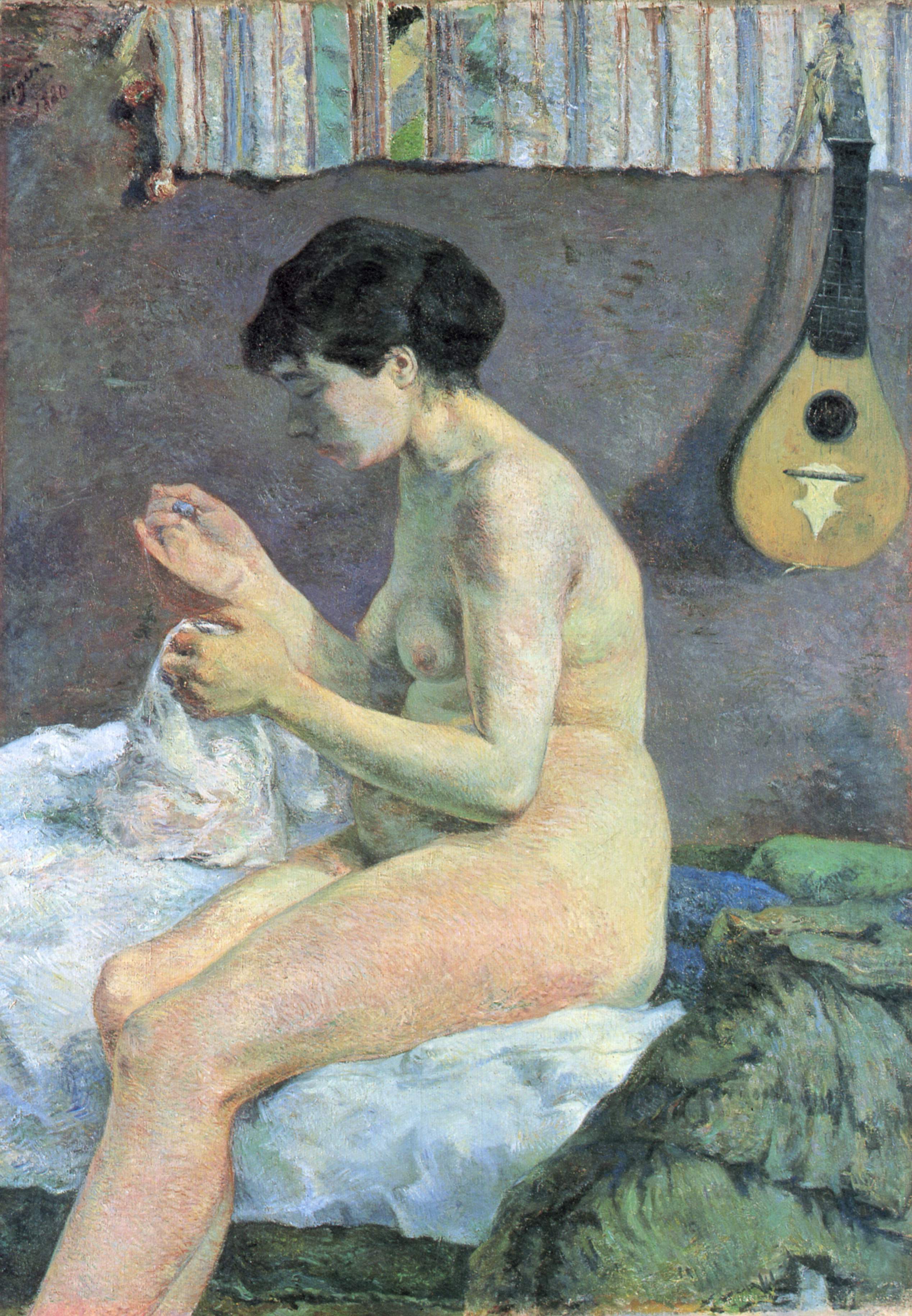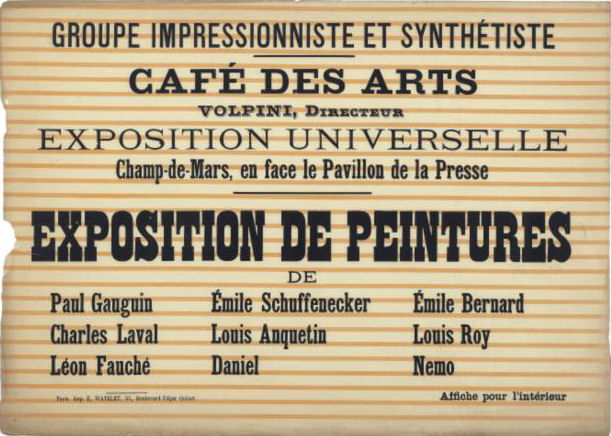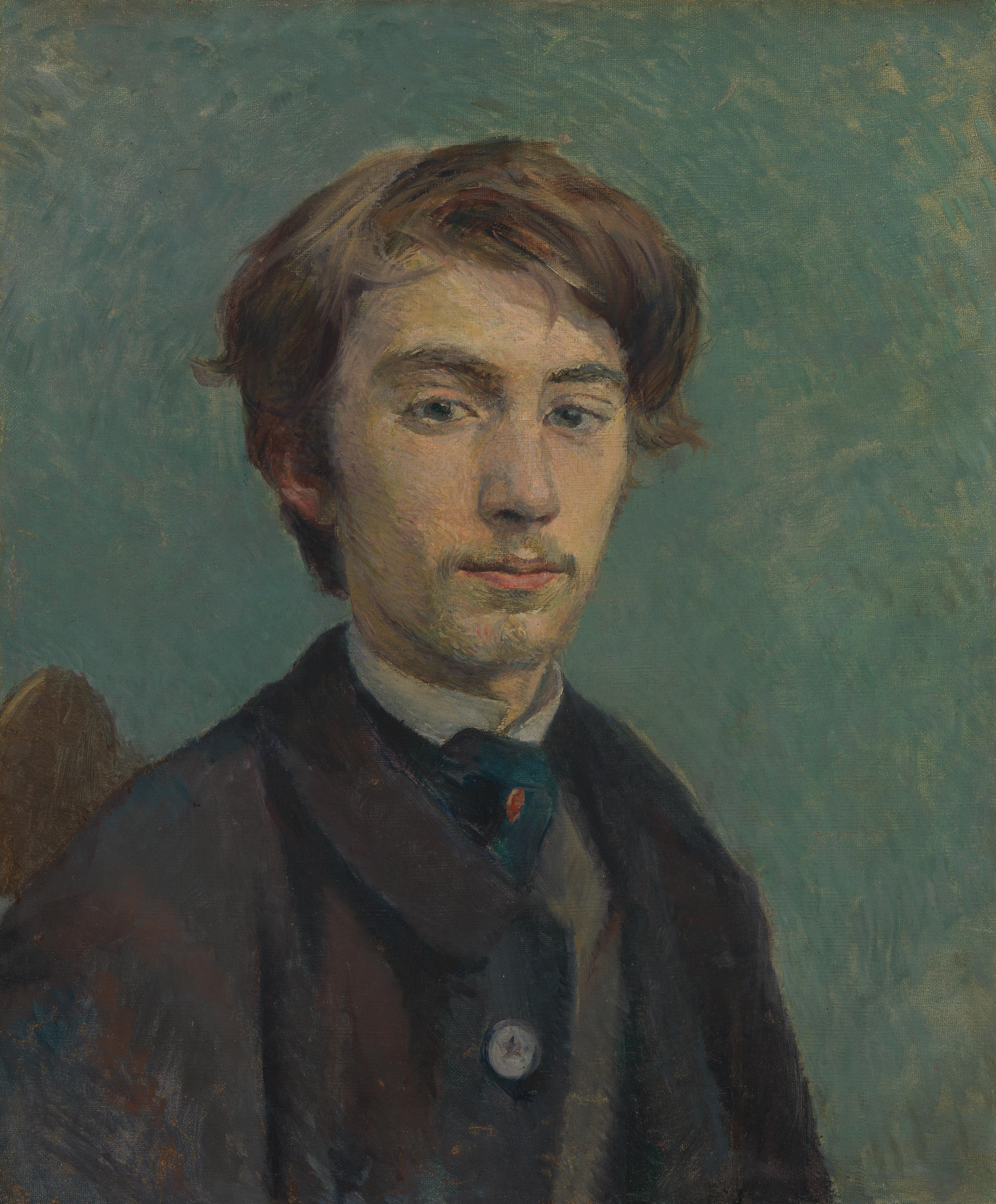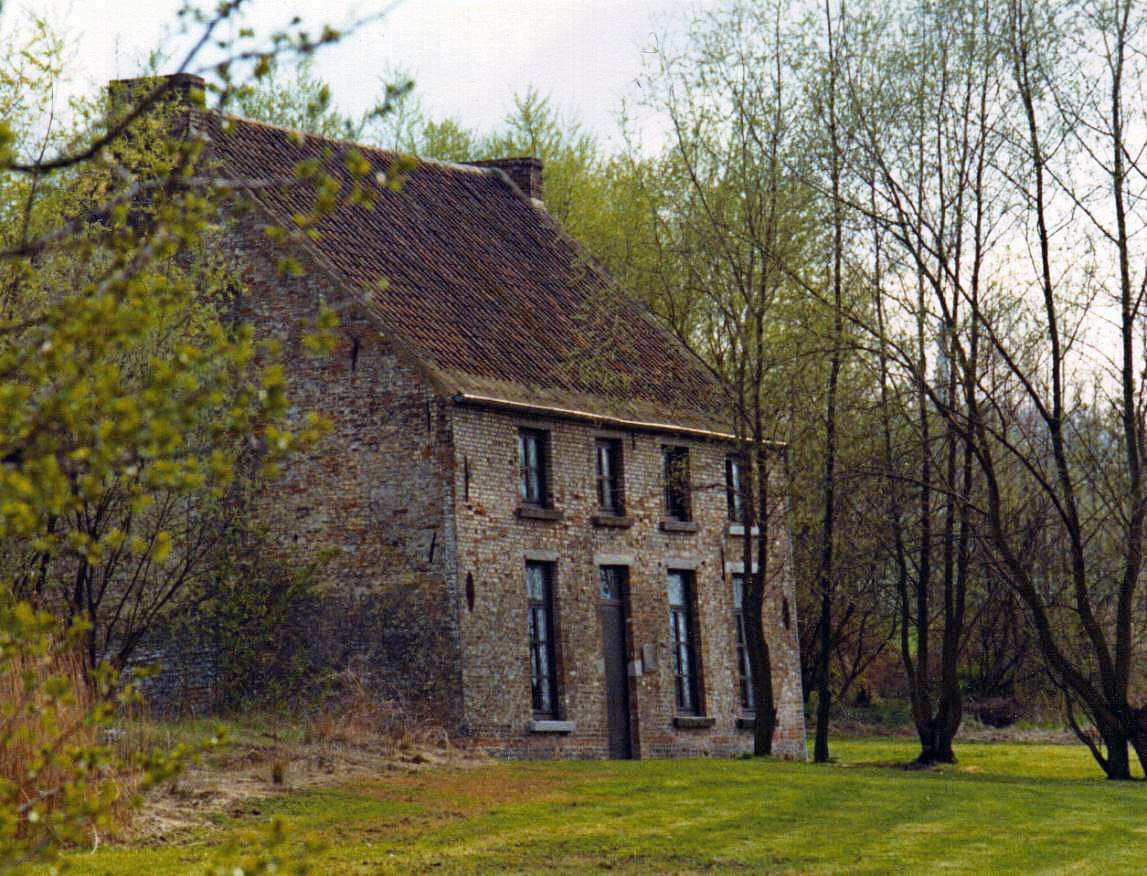|
Synthetist
Synthetism is a term used by Post-Impressionist artists like Paul Gauguin, Émile Bernard and Louis Anquetin to distinguish their work stylistically from Impressionism. Earlier, ''Synthetism'' has been connected to the term Cloisonnism, and later to Symbolism. The term is derived from the French verb ''synthétiser'' (''to synthesize'' or ''to combine so as to form a new, complex product''). History Paul Gauguin, Émile Bernard, Louis Anquetin, and others pioneered the style during the late 1880s and early 1890s. Synthetist artists aimed to ''synthesize'' three features: *The outward appearance of natural forms. *The artist's feelings about their subject. *The purity of the aesthetic considerations of line, colour and form. In 1890, Maurice Denis summarized the goals for synthetism as, :''It is well to remember that a picture before being a battle horse, a nude woman, or some anecdote, is essentially a flat surface covered with colours assembled in a certain order.'' The term ... [...More Info...] [...Related Items...] OR: [Wikipedia] [Google] [Baidu] |
Paul Gauguin
Eugène Henri Paul Gauguin (; ; 7 June 1848 – 8 May 1903) was a French painter, sculptor, printmaker, ceramist, and writer, whose work has been primarily associated with the Post-Impressionist and Symbolist movements. He was also an influential practitioner of wood engraving and woodcuts as art forms. While only moderately successful during his life, Gauguin has since been recognized for his experimental use of color and Synthetist style that were distinct from Impressionism. Gauguin was born in Paris in 1848, amidst the tumult of Europe's revolutionary year. In 1850, Gauguin's family settled in Peru, where he experienced a privileged childhood that left a lasting impression on him. Later, financial struggles led them back to France, where Gauguin received formal education. Initially working as a stockbroker, Gauguin started painting in his spare time, his interest in art kindled by visits to galleries and exhibitions. The financial crisis of 1882 significantly impact ... [...More Info...] [...Related Items...] OR: [Wikipedia] [Google] [Baidu] |
The Volpini Exhibition, 1889
The Volpini Exhibition was an exhibition of paintings arranged by Paul Gauguin and his circle held at the Café des Arts on the Champ de Mars, not far from the official art pavilion of the 1889 '' Exposition universelle'' in Paris. Lucie-Smith, Edward (1972). ''Symbolist Art''. London: Thames & Hudson, p. 94. A poster and an illustrated catalogue were printed, but the show of "Paintings by the Impressionist and Synthetist Group", held in June and early July 1889, was ignored by the press and proved to be a failure. Background The official art exhibition at the Académie des Beaux-Arts accompanying the ''Exposition universelle'' displayed works by invited artists only, and the selection of works to be exhibited had to pass the judgement of official juries. Neither Gauguin nor his friends could hope to enter this exhibition. However, by chance Emile Schuffenecker found another way that they might present their work to the public in conjunction with the exposition. Monsieur Volpini ... [...More Info...] [...Related Items...] OR: [Wikipedia] [Google] [Baidu] |
Émile Bernard
Émile Henri Bernard (; 28 April 1868 – 16 April 1941) was a French Post-Impressionist painter and writer, who had artistic friendships with Vincent van Gogh, Paul Gauguin and Eugène Boch, and at a later time, Paul Cézanne. Most of his notable work was accomplished at a young age, in the years 1886 through 1897. He is also associated with Cloisonnism and Synthetism, two late 19th-century art movements. Less known is Bernard's literary work, comprising plays, poetry, and art criticism as well as art historical statements that contain first-hand information on the crucial period of modern art to which Bernard had contributed. Biography Émile Henri Bernard was born in Lille, France, in 1868. As in his younger years his sister was sick, Émile was unable to receive much attention from his parents; he therefore stayed with his grandmother, who owned a laundry in Lille, employing more than twenty people. She was one of the greatest supporters of his art. The family moved to P ... [...More Info...] [...Related Items...] OR: [Wikipedia] [Google] [Baidu] |
Post-Impressionism
Post-Impressionism (also spelled Postimpressionism) was a predominantly French art movement that developed roughly between 1886 and 1905, from the last Impressionist exhibition to the birth of Fauvism. Post-Impressionism emerged as a reaction against Impressionists' concern for the naturalistic depiction of light and colour. Its broad emphasis on abstract qualities or symbolic content means Post-Impressionism encompasses Les Nabis, Neo-Impressionism, Symbolism, Cloisonnism, the Pont-Aven School, and Synthetism, along with some later Impressionists' work. The movement's principal artists were Paul Cézanne (known as the father of Post-Impressionism), Paul Gauguin, Vincent van Gogh and Georges Seurat. The term Post-Impressionism was first used by art critic Roger Fry in 1906.Peter Morrin, Judith Zilczer, William C. Agee, ''The Advent of Modernism. Post-Impressionism and North American Art, 1900-1918'', High Museum of Art, 1986 Critic Frank Rutter in a review of the Salon ... [...More Info...] [...Related Items...] OR: [Wikipedia] [Google] [Baidu] |
Cuno Amiet
Cuno Amiet (28 March 1868 – 6 July 1961) was a Swiss painter, illustrator, graphic artist and sculptor. As the first Swiss painter to give precedence to colour in composition, he was a pioneer of modern art in Switzerland. Biography Amiet was born in Solothurn, and was the son of the chancellor of the canton of Solothurn, Josef Ignaz Amiet (1827–1895). He attended the Kantonsschule Solothurn, where he graduated with the ''Matura'' in 1883. After studies with the painter Frank Buchser, he attended the Academy of Fine Arts Munich in 1886–88, where he befriended Giovanni Giacometti. In 1888–92, Giacometti and Amiet continued their studies in Paris, where Amiet studied at the Académie Julian under Adolphe-William Bouguereau, Tony Robert-Fleury and Gabriel Ferrier. Dissatisfied with academic art, Amiet joined the Pont-Aven School in 1892, where he learned from Émile Bernard (painter), Émile Bernard, Paul Sérusier, Roderic O'Conor and Armand Séguin (painter), Armand Ség ... [...More Info...] [...Related Items...] OR: [Wikipedia] [Google] [Baidu] |
Vincent Van Gogh
Vincent Willem van Gogh (; 30 March 185329 July 1890) was a Dutch Post-Impressionist painter who is among the most famous and influential figures in the history of Western art. In just over a decade, he created approximately 2,100 artworks, including around 860 oil paintings, most of them in the last two years of his life. His oeuvre includes Trees and Undergrowth (Van Gogh series), landscapes, Still life paintings by Vincent van Gogh (Paris), still lifes, Portraits by Vincent van Gogh, portraits, and Portraits of Vincent van Gogh, self-portraits, most of which are characterised by bold colours and dramatic Paintwork, brushwork that contributed to the rise of expressionism in modern art. Van Gogh's work was only beginning to gain critical attention before he died from a self-inflicted gunshot at age 37. During his lifetime, only one of Van Gogh's paintings, ''The Red Vineyard'', was sold. Born into an upper-middle-class family, Van Gogh drew as a child and was serious, qui ... [...More Info...] [...Related Items...] OR: [Wikipedia] [Google] [Baidu] |
Arles
Arles ( , , ; ; Classical ) is a coastal city and Communes of France, commune in the South of France, a Subprefectures in France, subprefecture in the Bouches-du-Rhône Departments of France, department of the Provence-Alpes-Côte d'Azur Regions of France, region, in the former Provinces of France, province of Provence. A large part of the Camargue, the largest wetlands in France, is located within the territory of the commune, which is the List of French communes by surface area, largest in Metropolitan France in terms of geographic territory. In non-metropolitan France, Maripasoula in French Guiana is the largest French commune in general. The commune's land area is roughly similar to that of Singapore. The city has a long history, and was of considerable importance in the Roman province of Gallia Narbonensis. The Arles, Roman and Romanesque Monuments, Roman and Romanesque Monuments of Arles were listed as UNESCO World Heritage Sites in 1981 for their testimony to the his ... [...More Info...] [...Related Items...] OR: [Wikipedia] [Google] [Baidu] |
The Green Christ
''The Green Christ'' (in French: ''Le Christ vert'') is an oil on canvas painting executed by Paul Gauguin in the Autumn of 1889 in Pont-Aven, Brittany. Together with ''The Yellow Christ'', it is considered to be one of the key-works of Symbolism in painting. It depicts a Breton woman at the foot of a calvary, or sculpture of Christ's crucifixion. Calvaries are common in town squares in Brittany. The woman appears to be hiding from a pair of figures in the distant background; the green Christ providing her cover from these people. Topographically, the site depicted is the Atlantic coast at Le Pouldu. But the calvary depicted is an amalgam of several calvaries from different places; the cross is based upon that in the centre of Névez, a community close to Pont-Aven, located several miles from the coast, and the figure of Christ is based upon the calvarie at Briec, also at some distance from the sea.Catherine Puget,'' Peintres de la Bretagne et quête spirituelle'', Musée de Pont ... [...More Info...] [...Related Items...] OR: [Wikipedia] [Google] [Baidu] |
Indianapolis Museum Of Art
The Indianapolis Museum of Art (IMA) is an encyclopedic art museum located at Newfields, a campus that also houses Lilly House, The Virginia B. Fairbanks Art & Nature Park, the Garden at Newfields and more. It is located at the corner of North Michigan Road and West 38th Street, about three miles north of downtown Indianapolis, northwest of Crown Hill Cemetery. There are exhibitions, classes, tours, and events, many of which change seasonally. The entire campus and organization was previously referred to as the Indianapolis Museum of Art, but in 2017 the campus and organization were renamed "Newfields" as part of a rebranding campaign. The "Indianapolis Museum of Art" now specifically refers to the main art museum building that acts as the cornerstone of the campus, as well as the legal name of the organization doing business as Newfields. The Indianapolis Museum of Art is the ninth oldest and eighth largest encyclopedic art museum in the United States. The permanent collec ... [...More Info...] [...Related Items...] OR: [Wikipedia] [Google] [Baidu] |



